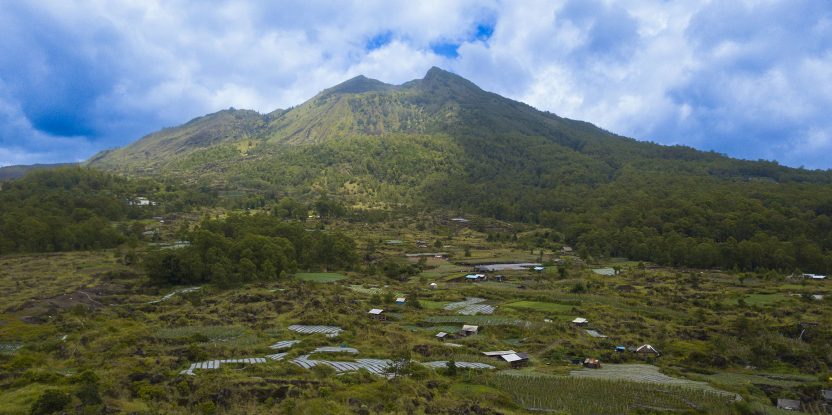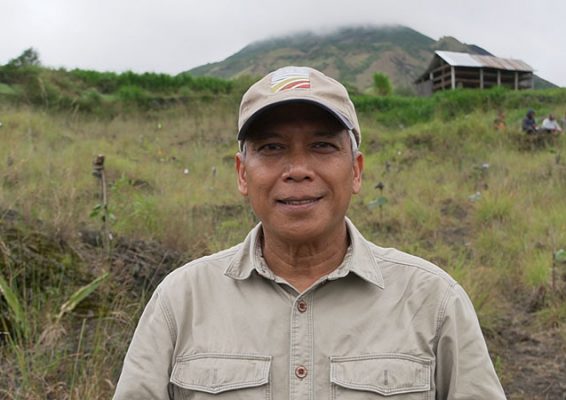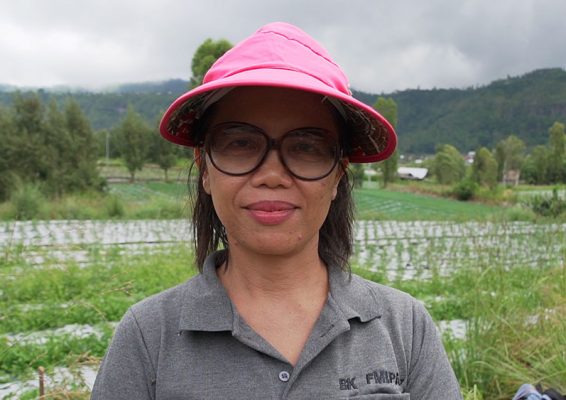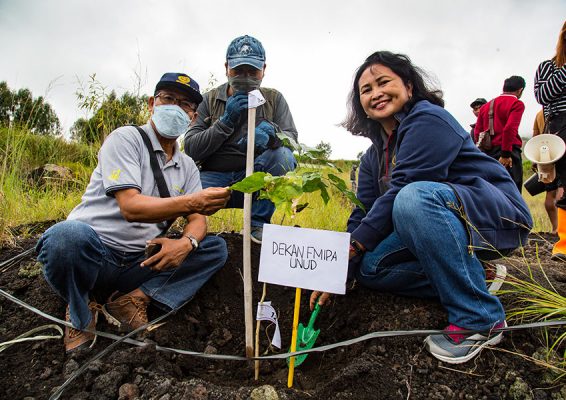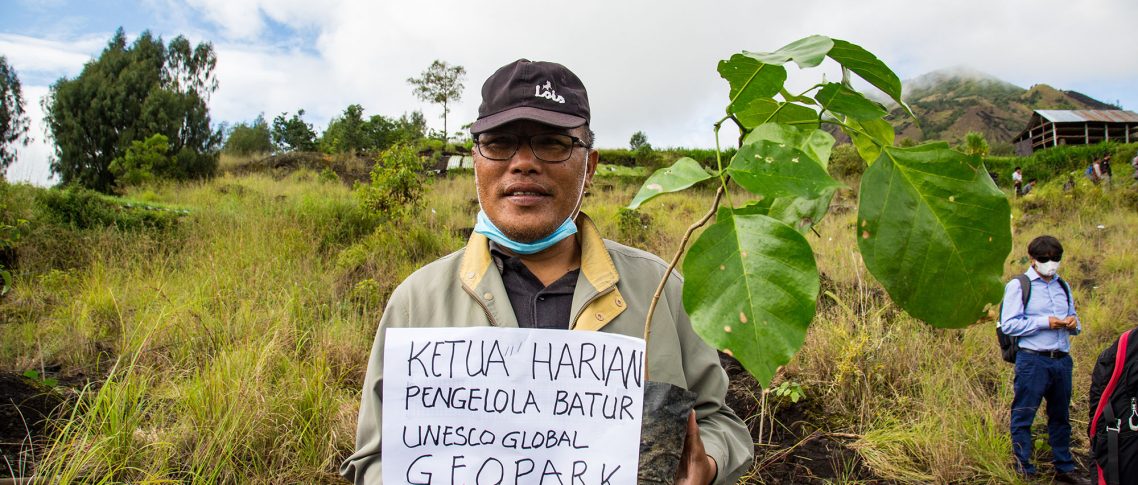Yet, this magnificence landscape comes at a price for local residents, who are among the poorest in Bali. The 15 villages in and around the caldera rely on unsustainable agricultural production, mainly growing vegetables, fruits and some tourism for their livelihoods. The degradation of the landscape has increased sediment runoff into the lake, reducing its depth and water quality, increasing flooding downstream and fostering growth of aquatic weeds. This presents an emerging threat to the communities reliant on the lake for drinking water, fish, cultural and religious practices, and recreational and cultural tourism.
In this complex scenario, the team of restorers on the misty morning in March unloaded a truck carrying 540 seedlings of Pongamia pinnata (also known as Millettia pinnata and locally as “malapari”) from a specialized nursery at the Watershed and Protected Forest Management Centre.
Some of the seedlings. Photo: CIFOR/Laurentius Angga
“A seedling seed orchard is a critically important first step in any restoration project,” explained Ni Luh Arpiwi, senior lecturer in seed domestication at Udayana University in southern Bali, who has been leading the cultivation of the seedlings.
“It provides high-quality seeds suited to local conditions that can be grown to produce more trees for expanding the scale of restoration. We have selected seeds from strong, healthy and productive trees from eastern, western and southern Bali, mostly from coastal areas because trees at higher altitudes have long since been cut for timber and other uses. The seeds were initially grown at the nursery of the government’s Watershed and Protected Forest Management Centre and then transferred to the university for further selection and care before being ready to plant today.”
Malapari, which is endemic to Bali, other parts of Indonesia and throughout Southeast Asia, is particularly well suited for restoring degraded land. It grows fast and well in most conditions, however degraded, such as the volcanic sand of Batur. Its leaf litter helps create fertile soil. It fixes nitrogen through its roots, meaning that less or no fertilizers are needed if other crops are grown nearby. Its canopy is also of a suitable shape for shading commodity crops, such as coffee and cacao. And last but not least, it produces seeds that have a high oil content suitable for use as biofuel, in cosmetics and for cooking.
“Malapari is little known yet holds great promise,” said Himlal Baral, senior land restoration scientist with the Center for International Forestry Research and World Agroforestry (CIFOR-ICRAF), who has initiated much of the restoration. “The SSO will not only provide seeds for the longer-term restoration work but serve as a research site for producing trees that can thrive and be most productive in the challenging conditions of the Geopark and beyond.”
Travelling especially for the planting from Yogyakarta in the neighboring island of Java, Budi Leksono, senior seed domestication expert with the Forestry Research and Development Agency of the Ministry of Environment and Forestry, has been sharing with Arpiwi and team his deep knowledge built over many decades of establishing and managing seed source orchards.
“The design of a SSO is critical to ensure good results,” he explained. “We have planted 30 families with three trees per plot and six replications so that we can compare performance. The weaker or underperforming individuals will be thinned to two trees per plot, leaving 180 trees at a final spacing of 5 x 6 meters.”
Budi Laksono. Photo: CIFOR/Laurentius Angga
Ni Luh Arpiwi. Photo: CIFOR/Laurentius Angga
Members of the Forest Farmers’ Group Bukit Pule had in days before prepared the site by clearing weeds and a pathway, jokingly called “Pongamia Street”, and digging holes to the initial spacing of 5 x 2 meters and depth and width dimensions advised by Arpiwi. On the planting day, along with the other restorers, they eagerly planted the seedlings despite the difficult terrain and inclement weather.
Planting underway. Photo: CIFOR/Laurentius Angga
Planting underway. Photo: CIFOR/Laurentius Angga
I Wayan Gobang Edy Sucipto, deputy director of the geopark, along with other colleagues from the geopark and District of Kintamani, was on site and planting. He was enthusiastic about the prospects for restoration and, particularly, the use of malapari.
“We fully support this work,” he said. “It will not only improve the overall environment and increase the tourism potential of the geopark but also enhance residents’ livelihoods, who are already showing their eagerness to use sustainable agricultural and forestry practices.”
More than 3000 seedlings of malapari had already been distributed to farmers to grow on their own land and more are to come to meet the demand.
“Farmers in the area have listened and now understand the benefits that can come from growing malapari together with coffee and other crops,” said Gobang.
I Wayan Gobang. Photo: CIFOR/Laurentius Angga
The seedling seed orchard is the first step in a large restoration program planned by the communities, the geopark, District of Kintamani, National Research and Innovation Agency (BRIN), Udayana University, Ministry of Forestry and Environment (MOEF), the Ministry of National Development Planning (Bappenas), Clean Power Indonesia, MOEF’s Forest Management Unit (KPH) East Bali, non-governmental organizations and the National Institute of Forest Science of the Republic of Korea.
“There are some 10,000 hectares of degraded land in the geopark and surrounds,” said Baral. “This calls not only for a coordinated local effort for restoration but also collaboration with national and international partners, such as the BRIN, MOEF and Korea’s National Institute of Forest Science.”
Korea has a long history of successful restoration of severely degraded land under extreme conditions that we are already learning from thanks to our collaboration through the Sustainable Community-based Reforestation and Enterprises project, which is funded by the Institute.”
Copyright policy:We want you to share Forests News content, which is licensed under Creative Commons
Attribution-NonCommercial-ShareAlike 4.0 International (CC BY-NC-SA 4.0). This means you are free to redistribute our material for non-commercial purposes. All we ask is that you give Forests News appropriate credit and link to the original Forests News content, indicate if changes were made, and distribute your contributions under the same Creative Commons license. You must notify Forests News if you repost, reprint or reuse our materials by contacting
forestsnews@cifor-icraf.org.
